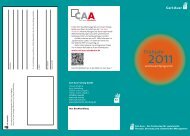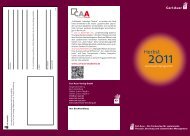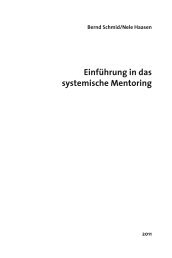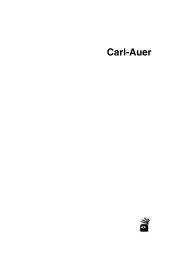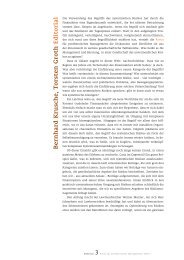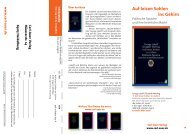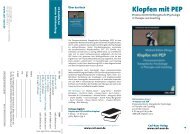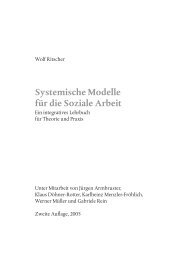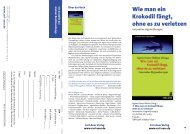K a trin G la tz e l E d ito ria l
K a trin G la tz e l E d ito ria l
K a trin G la tz e l E d ito ria l
Erfolgreiche ePaper selbst erstellen
Machen Sie aus Ihren PDF Publikationen ein blätterbares Flipbook mit unserer einzigartigen Google optimierten e-Paper Software.
Since consumer needs, technologies, political forces, and<br />
competitive strategies are in constant flux, any company<br />
with a static view of coordination needs, or an inflexible<br />
approach to problems will face significant difficulties,<br />
not unlike those of ITT.<br />
The very nature of the transnation-<br />
al organization dramatically<br />
expands the number of issues that<br />
have to be integrated<br />
Most companies tend to concentrate on one primary<br />
mechanism for coordination and control – one »way of<br />
doing things.« At ITT, for example, it was »the sys-<br />
tem« – Harold Geneen’s sophisticated control mecha-<br />
nisms, which were highly formalized and institutional-<br />
ized throughout the organization. At Kao, coordination<br />
and control were achieved primarily through centralization<br />
of decision making; corporate management was<br />
directly involved in most strategic and even operation-<br />
al tasks. Unilever relied primarily on socialization –<br />
an intricate process of instilling a common culture and<br />
a shared perspective in all managers – to hold the organization<br />
together and integrate managers responsible<br />
for different areas and functions. But no single mechanism<br />
can deal with the complex coordination needs<br />
that arise in worldwide companies.<br />
The transnational requires highly flexible coordination<br />
processes to cope with both short-term shifts in specific<br />
role assignments and long-term realignments of<br />
basic responsibilities and reporting re<strong>la</strong>tionships. Furthermore,<br />
it must be capable of modifying roles and re<strong>la</strong>tionships<br />
on a decision-by-decision basis. The company<br />
must develop multiple means of coordination and allocate<br />
its scarce coordinating resources on the basis of a<br />
careful assessment of specific task demands. 17<br />
The very nature of the transnational organization<br />
dramatically expands the number of issues that have to<br />
be integrated. But three flows are crucial. First, the company<br />
has to coordinate the flow of parts, components,<br />
and finished goods. Second, it must manage the flow of<br />
funds, skills, and other scarce resources among units.<br />
Third, it must link the flow of intelligence, ideas, and<br />
........<br />
knowledge that are central to its innovation and learning<br />
capabilities.<br />
The transnational company builds a portfolio of coor-<br />
dinating processes that includes centralization (substantive<br />
decision making by senior management), formalization<br />
(institutionalization of systems and procedures to guide<br />
choices), and socialization (building a context of common<br />
purpose, values, and perspectives among managers to influence<br />
their judgments). 18 It uses the entire portfolio,<br />
rather than just one process, to achieve a richer and more<br />
differentiated kind of coordination. The flow of parts,<br />
components, and products is often managed through systems;<br />
the flow of resources is usually directed through<br />
more substantive involvement of top management; and<br />
the flow of information and knowledge may be facili-<br />
tated primarily through mechanisms that lead to norma-<br />
tive integration of managers and to a common culture<br />
and unifying vision. Simi<strong>la</strong>rly, different parts of the<br />
organization may be managed differently: some businesses,<br />
functions, and areas may require more direction<br />
and centralization, while formalization or socialization<br />
may be the primary integrative process in others.<br />
Chapter 9 will examine how the transnational develops<br />
and deploys its diverse coordination tools. We will<br />
draw on the experiences of Philips, Unilever, and Ericsson<br />
to illustrate the process of differentiation in coordinative<br />
processes and to exp<strong>la</strong>in the choice of different<br />
tools for different tasks. We shall also describe how<br />
such companies use both the visible hand of managed<br />
integration and the invisible hand of coordination<br />
through internal market mechanisms to build powerful<br />
centripetal forces and counterba<strong>la</strong>nce the pressures of<br />
fragmentation that are unavoidable in the transnational<br />
mode of operation. 19<br />
Unifying the Organization Through Vision and Cooption<br />
Transnational management processes differ from those<br />
of more traditional organizations in two significant<br />
ways. First, the reliance on control tends to erode as unidimensional<br />
systems and practices are supplemented by<br />
new coordination mechanisms. Second, the processes are<br />
managed in a differentiated fashion, not only from issue<br />
to issue, but across businesses and organizational units.<br />
Internal differentiation in organizational roles and<br />
management processes can lead to severe conflict within<br />
The Transnational 30 Revue für postheroisches Management / Heft 5



